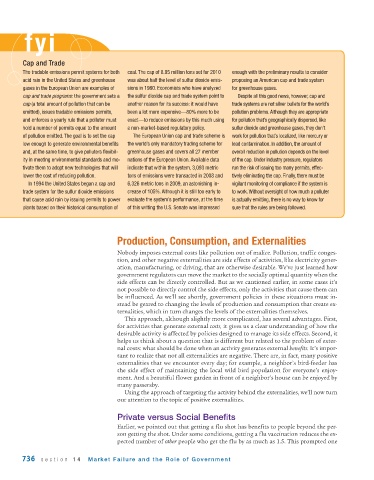Page 778 - Krugmans Economics for AP Text Book_Neat
P. 778
fyi
Cap and Trade
The tradable emissions permit systems for both coal. The cap of 8.95 million tons set for 2010 enough with the preliminary results to consider
acid rain in the United States and greenhouse was about half the level of sulfur dioxide emis- proposing an American cap and trade system
gases in the European Union are examples of sions in 1980. Economists who have analyzed for greenhouse gases.
cap and trade programs: the government sets a the sulfur dioxide cap and trade system point to Despite all this good news, however, cap and
cap (a total amount of pollution that can be another reason for its success: it would have trade systems are not silver bullets for the world’s
emitted), issues tradable emissions permits, been a lot more expensive—80% more to be pollution problems. Although they are appropriate
and enforces a yearly rule that a polluter must exact—to reduce emissions by this much using for pollution that’s geographically dispersed, like
hold a number of permits equal to the amount a non-market-based regulatory policy. sulfur dioxide and greenhouse gases, they don’t
of pollution emitted. The goal is to set the cap The European Union cap and trade scheme is work for pollution that’s localized, like mercury or
low enough to generate environmental benefits the world’s only mandatory trading scheme for lead contamination. In addition, the amount of
and, at the same time, to give polluters flexibil- greenhouse gases and covers all 27 member overall reduction in pollution depends on the level
ity in meeting environmental standards and mo- nations of the European Union. Available data of the cap. Under industry pressure, regulators
tivate them to adopt new technologies that will indicate that within the system, 3,093 metric run the risk of issuing too many permits, effec-
lower the cost of reducing pollution. tons of emissions were transacted in 2008 and tively eliminating the cap. Finally, there must be
In 1994 the United States began a cap and 6,326 metric tons in 2009, an astonishing in- vigilant monitoring of compliance if the system is
trade system for the sulfur dioxide emissions crease of 105%. Although it is still too early to to work. Without oversight of how much a polluter
that cause acid rain by issuing permits to power evaluate the system’s performance, at the time is actually emitting, there is no way to know for
plants based on their historical consumption of of this writing the U.S. Senate was impressed sure that the rules are being followed.
Production, Consumption, and Externalities
Nobody imposes external costs like pollution out of malice. Pollution, traffic conges-
tion, and other negative externalities are side effects of activities, like electricity gener-
ation, manufacturing, or driving, that are otherwise desirable. We’ve just learned how
government regulators can move the market to the socially optimal quantity when the
side effects can be directly controlled. But as we cautioned earlier, in some cases it’s
not possible to directly control the side effects, only the activities that cause them can
be influenced. As we’ll see shortly, government policies in these situations must in-
stead be geared to changing the levels of production and consumption that create ex-
ternalities, which in turn changes the levels of the externalities themselves.
This approach, although slightly more complicated, has several advantages. First,
for activities that generate external costs, it gives us a clear understanding of how the
desirable activity is affected by policies designed to manage its side effects. Second, it
helps us think about a question that is different but related to the problem of exter-
nal costs: what should be done when an activity generates external benefits. It’s impor-
tant to realize that not all externalities are negative. There are, in fact, many positive
externalities that we encounter every day; for example, a neighbor’s bird-feeder has
the side effect of maintaining the local wild bird population for everyone’s enjoy-
ment. And a beautiful flower garden in front of a neighbor’s house can be enjoyed by
many passersby.
Using the approach of targeting the activity behind the externalities, we’ll now turn
our attention to the topic of positive externalities.
Private versus Social Benefits
Earlier, we pointed out that getting a flu shot has benefits to people beyond the per-
son getting the shot. Under some conditions, getting a flu vaccination reduces the ex-
pected number of other people who get the flu by as much as 1.5. This prompted one
736 section 14 Market Failure and the Role of Gover nment

